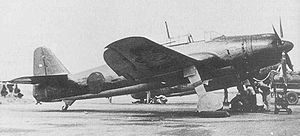Aichi B7A
| B7A Ryusei | |
|---|---|
 |
|
| Role | Torpedo bomber and Dive bomber |
| Manufacturer | Aichi Kokuki KK |
| First flight | May 1942 |
| Retired | September 1945 |
| Status | Retired |
| Primary user | Imperial Japanese Navy Air Service |
| Produced | 1941–45 |
| Number built | 114 total 9 - B7A1 105 - B7A2 |
The Aichi B7A Ryusei (流星 Ryūsei?, "Shooting Star", Allied reporting name "Grace") was a large and powerful carrier-borne torpedo-dive bomber produced by Aichi Kokuki KK for the Imperial Japanese Navy Air Service during the Second World War. Built in only small numbers and deprived of the aircraft carriers it was intended to operate from, the type had little chance to distinguish itself in combat before the war ended in August 1945.
The B7A Ryusei (originally designated AM-23 by Aichi) was designed in response to a 1941 16-Shi requirement issued by the Imperial Japanese Navy Air Service for a carrier attack bomber that would replace both the Nakajima B6N Tenzan torpedo plane and the Yokosuka D4Y Suisei dive bomber in IJN service. It was intended for use aboard a new generation of Taihō-class carriers, the first of which was laid down in July 1941. Because the deck elevators on the Taihōs had a larger square area than those of older Japanese carriers, the longstanding maximum limit of 11 m (36 ft) on carrier aircraft length could now be lifted.
Chief Engineer Toshio Ozaki (name often seen as Norio Ozaki, but this is incorrect because the Kanji for both first names are the same and often confused) chose a mid-wing arrangement for the B7A to provide for an internal bomb-bay and to ensure enough clearance for the plane's 3.5 m (11 ft) four-bladed propeller. This in turn necessitated the adoption of an inverted gull wing, reminiscent of the F4U Corsair, in order to shorten the length of the main landing gear. The wing featured extendable ailerons with a ten-degree range of deflection, enabling them to act as auxiliary flaps. Dive brakes were fitted underneath just outboard of the fuselage. The B7A's outer wing panels were designed to fold upwards hydraulically for carrier stowage, reducing its overall span from 14.4 m (47 ft) to approximately 7.9 m (26 ft).
...
Wikipedia
